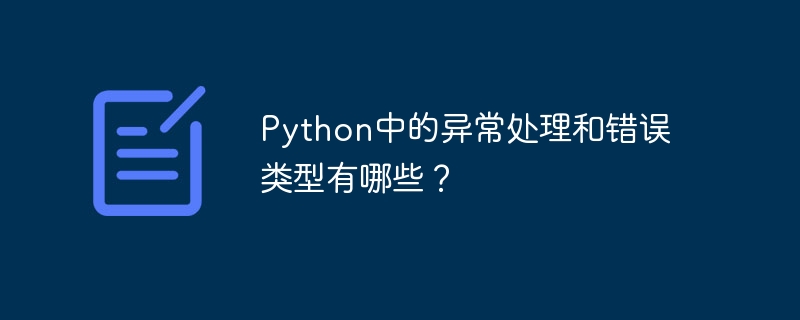Home >Backend Development >Python Tutorial >What are the exception handling and error types in Python?
What are the exception handling and error types in Python?
- PHPzOriginal
- 2023-10-18 12:00:49865browse

What are the exception handling and error types in Python?
Python is a very popular programming language that provides a powerful exception handling mechanism, allowing developers to better control and handle errors that may occur in the code. In Python, exceptions refer to problems or errors that may be encountered during code execution, and exception handling is a mechanism used to catch and handle these exceptions to avoid program crashes or failure to execute normally.
In Python, exception handling is completed by the try-except statement block. The try block is used to contain code that may raise exceptions, while the except statement block is used to handle raised exceptions. The following is a simple example:
try:
x = 5 / 0 # 0作为除数会引发ZeroDivisionError异常
print(x)
except ZeroDivisionError:
print("除以0错误")In the above example, we put the code for dividing by 0 in the try code block. When the code is executed here, dividing by 0 will cause a ZeroDivisionError exception. , so the program will jump to the corresponding except statement block for execution. In the except block, we print an error message "Division by 0 error".
In addition to using the except statement block to handle specific types of exceptions, we can also use one except statement block to handle multiple types of exceptions, or use one except statement block to handle all unhandled exceptions. The following is an example of handling multiple exceptions:
try:
x = int(input("请输入一个整数:"))
y = 5 / x
print(y)
except ValueError:
print("输入错误,必须输入一个整数")
except ZeroDivisionError:
print("除以0错误")
except:
print("其他未知错误")In the above example, we first try to read the integer entered by the user. If the input value cannot be converted to an integer, a ValueError exception will be raised; if the input value If it is 0, a ZeroDivisionError exception will be raised; if other types of errors are entered, they will be processed by the last except statement block. Finally, we printed the corresponding error messages respectively.
In addition to the two common exception types mentioned above, Python also provides many other built-in exception types for handling specific types of errors. Here are some common exception types and their descriptions:
- TypeError: Raised during an operation of incompatible types, such as adding a string to an integer.
- IndexError: Raised when accessing a non-existent index in a list, tuple or string.
- KeyError: Raised when accessing a key that does not exist in the dictionary.
- FileNotFoundError: Raised when trying to open a file that does not exist.
Of course, in addition to using Python's built-in exception types, we can also customize our own exception types. Custom exception types can inherit from Python's built-in exception types, allowing us to better organize and manage exceptions in the code.
In summary, Python provides a powerful and flexible exception handling mechanism to help us effectively capture and handle errors that may occur during program execution. By using exception handling appropriately, we can better debug and optimize our code and improve the stability and robustness of the code.
The above is the detailed content of What are the exception handling and error types in Python?. For more information, please follow other related articles on the PHP Chinese website!

